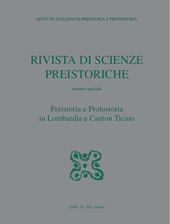Il sito D del Lucone di Polpenazze del Garda (BS) : un breve quadro di sintesi
P. 477-491
Lucone D is one of the five settlements identified during the excavations in the basin of the former Lake Lucone in the municipal area of Polpenazze del Garda (BS). The site was discovered in 1986; research there was resumed in 2007 (with Ministerial authorization) by the Museo Archeologico della Valle Sabbia, Gavardo (BS), and continued until the present. The summer excavation campaigns permitted the investigation of an area covering 190 m2 (Sector 1), with a recent enlargement of 153 m2 (Sector 2) which is still in course of excavation. The site suffered little agricultural damage, was occupied relatively briefly, and is remarkable by the exceptional state of preservations of its timber structures. These characteristics make it an ideal setting for research on structural and palaeoenvironmental aspects of this Early Bronze Age pile-dwelling site.
Dendrochronology has thrown light on the site's history: the first trees felled for building the village have been dated to 2034 (±10) cal BC, while the latest such activity dates to 1967 cal BC (±10). Between these two dates numerous felling phases have been identified, which correspond to episodes of building activity or restoration. With regard to the stratigraphy, a first occupation phase has been recognized (LUD1), which was terminated by a fire, and then a second phase (LUD2) that may be divided into several sub-phases and is sealed by a layer formed after its abandonment. The deposits associated with the fire are particularly interesting, since they provide a sort of ‘snapshot' of true life in the village, with the preservation of numerous wooden components of the standing walls, as well as items of material culture buried in the collapse.
The blaze also led to the preservation of structures in unfired clay which do not usually survive. The Lucone D layers contain a large quantity of finds, including a lot of pottery, as well as items in metal, bone and antler, stone and perishable materials. The metalwork and pottery have provided much cultural details concerning the Polada Culture that flourished during the Early Bronze Age 1. The numerous geoarchaeological data obtained from the study of refuse deposits, together with palaeobotanical and archaeozoological information, round out the picture, helping us to understand important aspects of the inhabitants' daily life and subsistence economy. [Publisher's text]
Fait partie de
Rivista di scienze preistoriche : LXXII, supplemento, 2022-
Articles du même numéro (disponibles individuellement)
-
Informations
Code DOI : 10.32097/1189
ISSN: 2282-457X


